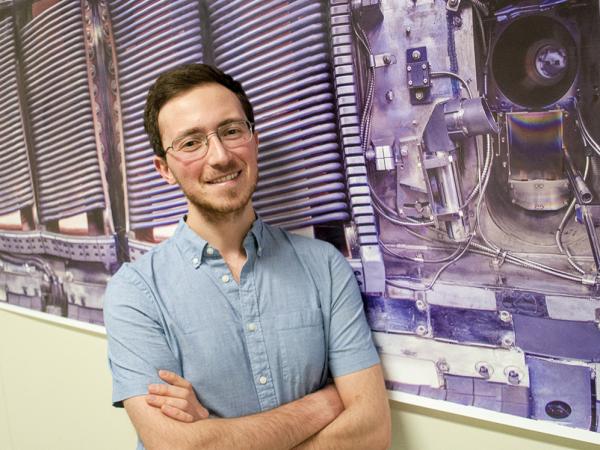
"Talking about one’s studies helps to crystallize personal ideas, share the excitement of a research project and explain to those in other disciplines why it is so important that we invest in science and technology," says PSFC graduate student Francesco Sciortino.
Paul Rivenberg
PhD candidate works behind the scenes to create learning opportunities for peers and the general public.
December 14, 2018
As a 3rd-year physics graduate student at MIT’s Plasma Science and Fusion Center (PSFC), Francesco Sciortino explores turbulence in fusion plasmas, under the guidance of Magnetic Fusion Experimental Division Head Earl Marmar and research scientist Nathan Howard. Just as the currents created by stirring hot coffee will cool the liquid, plasma turbulence causes the hot plasma fuel in a tokamak to lose heat, limiting the potential fusion energy. By injecting heavy atoms into the plasma as tracers and measuring and modeling the radiation emitted, Sciortino can develop a better understanding of collisional and turbulent processes.
Having grown up in central Italy before finishing high school in England, he traces his original interest in fusion to when he organized a school visit to the Culham Centre for Fusion Energy while he was a student at Imperial College London. In an article published in Nature, Why organizing a scientific conference can produce huge benefits, Sciortino summarized the rewards to students of joining peer groups and organizing scientific programs.
What aspect of your plasma research do you enjoy most?
I particularly like the multiplicity of its purpose. The results of my computational analysis are useful in validating turbulence theories, in experimentally proving or disproving elements of complex theoretical models. On the other hand, these results also provide key information on how impurities behave in different high-confinement tokamak scenarios. This establishes which operational regimes are attractive for a burning plasma and which are not viable, since impurities strongly reduce the rate of fusion reactions in the core of the plasma and radiate away energy that we would like to keep well confined. Removing these heavy ions effectively is not a simple task. During my PhD, I am hoping to bring to life new techniques that combine knowledge from a variety of fields, ranging from statistics to atomic physics and statistical mechanics.
How did you get involved in organizing science activities?
Already as a high school student, I became active in organizing volunteer groups, public talks and music events. Once at university, I joined groups of physics students who wanted to explore several fields of research, organize scientific talks and socialize within their department. This led to my involvement in the foundation of the Italian Association of Physics Students, which in the last 4 years has grown to around 1000 members. Although I was studying in England, I felt very connected with my friends in the Association and I invested significant time organizing visits to laboratories around Europe. It was through one of these, at the Culham Laboratory of Fusion Energy, that my interest in fusion was sparked.
How has the process of organizing events in Europe helped you as part of the MIT Community?
My involvement in student associations has been extremely impactful on my path to MIT. During my first year at MIT, I worked on the organization of the International Conference of Physics Students, held in Turin (Italy) in August 2017. This required a lot of team work and was a great success! In my second year at MIT, I decided that I wanted to change pace and focus on smaller, closer communities, so I became a hall councilor in my graduate residence (MIT Sidney Pacific). Having organized many events before coming to MIT, I am certainly not shy about proposing new ideas to help residents socialize. The skills I have picked up along the way help me live up to very active standards, in a community that rewards those who play in teams, work hard and look constantly for new opportunities.
At the beginning of this year I joined a group of volunteers who are reforming the charter and regulations of the International Association of Physics Students. Having been part of the Executive Committee of this association some years ago, I am enjoying giving back to this community with the experience that I have gained.
What has your outreach experience at the PSFC been like?
Although my involvement in physics outreach was only occasional while in Europe, I have come to enjoy it much more since I joined the PSFC. Here, the outreach program allows me to share my enthusiasm, answering questions that are simple at times, and complex at others. I have been a tour guide of Alcator C-Mod, describing to visitors the historical achievements of MIT in the field of plasma physics, and explaining the future that we foresee with SPARC. Engaging in longer discussions with interested visitors is a wonderfully rewarding experience, for which I always like to take some time off my schedule. I am also in the process of planning some outreach in Italy for the month of December, when I will briefly go back to my hometown. During this event I hope to inspire some high school students to pursue their interests in science and technology, as well as explore opportunities to study or get work experience in international contexts.
What is the value of doing outreach for the field of plasma science?
I value outreach as a natural part of a scientist’s profession. Talking about one’s studies helps to crystallize personal ideas, share the excitement of a research project and explain to those in other disciplines why it is so important that we invest in science and technology. The key mission of the PSFC in making the path to fusion energy faster and cheaper requires the support and involvement of as many people as possible—not just the leaders of today, but also those of tomorrow, citizens of this country or any other.
Topics: Magnetic fusion energy, Plasma turbulence, Earl Marmar